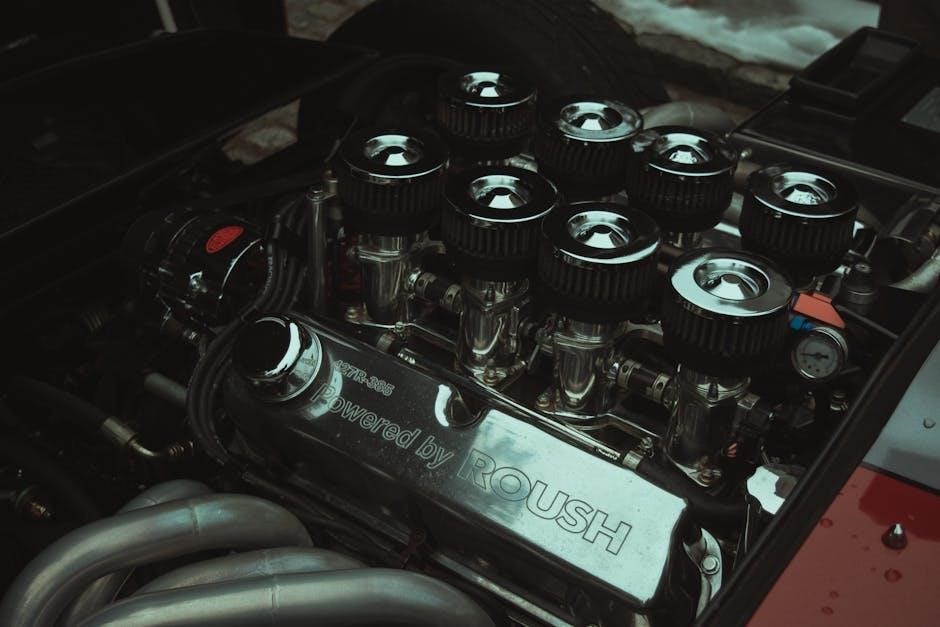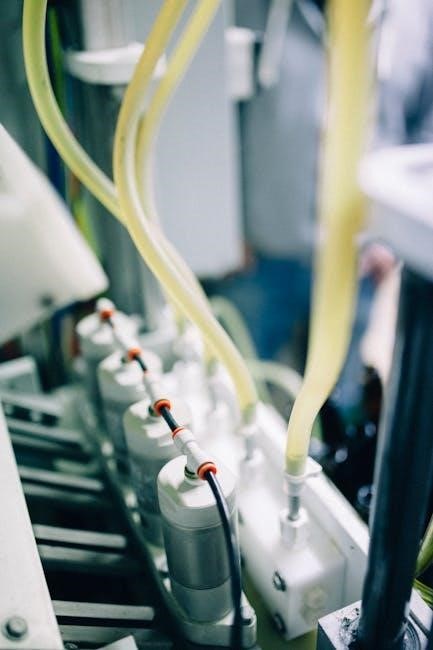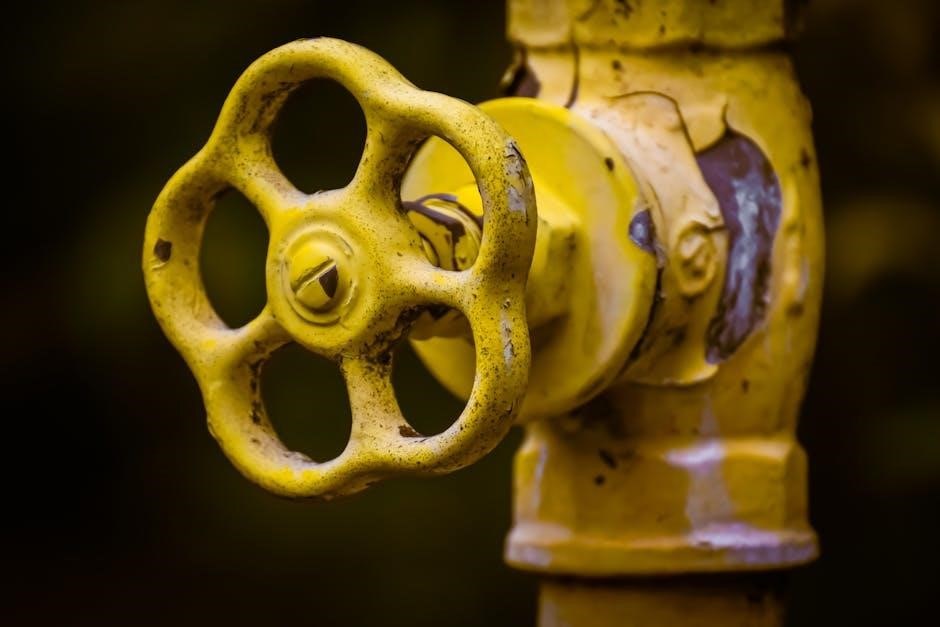knurling valve guides

Knurling valve guides is a proven method to restore worn valve guide clearance‚ offering a cost-effective alternative to replacement while extending engine life and enhancing performance.
Overview of Knurling and Its Importance
Knurling is a machining process that creates a textured surface pattern‚ often used on valve guides to improve durability and reduce wear. This technique enhances the guide’s ability to retain lubrication and withstand high-temperature engine environments. By restoring worn surfaces‚ knurling extends the lifespan of valve guides‚ maintaining engine performance and reducing the need for costly replacements. It is a critical maintenance method in engine repair.
Historical Context and Evolution
Knurling has been utilized in engineering for decades‚ with early applications in creating textured surfaces for improved grip and wear resistance. The technique evolved into a precise method for valve guide restoration‚ particularly in automotive and industrial contexts. Over time‚ advancements in tooling and machinery have refined the process‚ making it a reliable solution for extending engine component lifespan and maintaining performance standards in modern engines.
The Knurling Process
Knurling involves creating a textured surface on valve guides using specialized tools‚ enhancing grip and durability while maintaining precise dimensional tolerances for optimal engine performance and longevity.
Preparation and Tooling Requirements
Preparation involves cleaning the valve guide bore and ensuring precise centering. Specialized knurling tools‚ such as knurling wheels and guide attachments‚ are essential. The setup requires proper alignment and secure clamping to maintain stability during the operation. Calibration of the tooling is critical to achieve the desired texture and dimension. Skilled technicians must carefully follow established procedures to ensure accuracy and consistency in the knurling process.
Execution of the Knurling Operation
The knurling operation involves feeding a specialized knurling tool into the valve guide bore under controlled pressure. The tool creates a textured surface by displacing material‚ enhancing grip. Proper alignment and consistent tool rotation are crucial. The process must be closely monitored to avoid over-deformation. The result is a resized bore with improved structural integrity‚ ready for valve stem reinstallation‚ ensuring optimal performance and durability.
Post-Machining Inspection and Quality Control
After knurling‚ the valve guide undergoes rigorous inspection to ensure dimensional accuracy and surface integrity. Measurements are taken to confirm the resized bore meets specifications. Visual checks are performed to detect any tool marks or damage. The surface finish is evaluated for proper texture and consistency. Final quality control ensures the knurled surface securely holds the valve stem‚ guaranteeing reliable engine performance and preventing future wear.
Advantages of Knurling Valve Guides
Knurling valve guides offers a cost-effective solution by extending engine life and enhancing performance‚ providing a reliable repair method without the need for replacement parts.
Improved Durability and Longevity
Knurling significantly enhances the durability of valve guides by reducing wear and tear. The process creates a tighter fit between the valve stem and guide‚ minimizing excessive movement that can lead to premature wear. This restoration method extends the lifespan of engine components‚ delaying the need for costly replacements and ensuring optimal performance over time.
Enhanced Surface Finish and Precision
Knurling creates a textured surface on valve guides‚ improving their durability and reducing wear. This process enhances precision by ensuring a tighter‚ more consistent fit between the valve stem and guide. The improved surface finish minimizes friction and extends the lifespan of the valve train‚ contributing to smoother engine operation and reduced mechanical failure risks over time.
Cost-Effectiveness Compared to Replacement
Knurling valve guides is a cost-effective solution compared to replacing them. It eliminates the need for expensive new parts and reduces labor costs. This method extends the life of existing components‚ making it a budget-friendly option for engine maintenance without compromising performance or durability‚ especially beneficial for older engines where replacement parts are scarce or costly.

Disadvantages and Limitations
Knurling valve guides may lead to increased wear over time‚ require specialized tools‚ and demand skilled labor‚ potentially complicating the process and its long-term reliability.
Potential for Increased Wear Over Time
Knurling valve guides‚ while durable‚ can experience increased wear over time due to friction and heat generated by engine operation. This wear may lead to reduced guide clearance.
If not executed properly‚ the knurled surface can deteriorate‚ compromising valve stem stability. Regular maintenance and inspections are crucial to mitigate this issue and ensure long-term performance reliability.
Complexity of the Knurling Process
The knurling process involves intricate tooling and precise machining‚ requiring specialized attachments. It demands skilled labor to ensure accurate pattern formation and uniform surface texture. Improper execution can lead to uneven wear or reduced guide efficiency. The process is further complicated by the need for exact alignment and controlled force application during machining.
For engines like the K2FC or flathead‚ additional steps may be necessary to accommodate unique design features‚ adding to the complexity. Advanced tools and expertise are essential to achieve optimal results;
Need for Skilled Labor and Specialized Tools
Knurling valve guides requires skilled labor to handle intricate tooling and precise machining. Specialized tools‚ such as custom knurling bits‚ are essential for creating the desired pattern without damaging the guide. The process demands expertise to ensure proper alignment and force application‚ avoiding uneven wear or guide failure. Proper training and understanding of engine mechanics are crucial for successful execution‚ particularly for unique engine designs like the K2FC or flathead.
Without skilled operators‚ the risk of improper knurling increases‚ potentially leading to reduced guide efficiency or engine performance issues. Specialized tools and knowledge are vital to achieve the precision needed for this process.
Applications of Knurled Valve Guides
Knurled valve guides are widely used in automotive engines‚ industrial machinery‚ and aerospace applications‚ providing durability and precision in high-performance environments where valve stem stability is critical.
Automotive Industry Applications
In the automotive sector‚ knurled valve guides are commonly employed to restore worn engine components‚ ensuring proper valve stem alignment and reducing oil consumption. This method is particularly favored for its cost-effectiveness and ability to extend the service life of engines without requiring complete overhaul‚ making it a preferred solution for both classic and modern vehicles.
Industrial and Heavy Machinery Uses
Knurled valve guides are widely utilized in industrial and heavy machinery to maintain precise valve alignment and reduce wear under harsh operating conditions. This method is particularly effective in extending the lifespan of large engines and machinery‚ ensuring optimal performance and minimizing downtime. The durability provided by knurling makes it a preferred choice for industries requiring reliable‚ long-lasting equipment operation.
Aerospace and High-Performance Engines
Knurled valve guides are critical in aerospace and high-performance engines‚ where precision and durability are paramount. The process enhances valve stem alignment and reduces wear under extreme conditions‚ ensuring reliable operation. This method is favored for its ability to maintain optimal performance in engines subjected to high stress and demanding environments‚ making it a vital component in advanced engine design and maintenance.

Tools and Machinery Required
Specialized knurling tools‚ such as knurling wheels and forming attachments‚ are essential for creating precise patterns on valve guides. Lathes and high-precision machinery are typically required.
Specialized Knurling Tools and Attachments
Knurling valve guides requires specialized tools‚ including knurling wheels and forming attachments. These tools create the necessary patterns and diameters. Diamond and round knurling wheels are commonly used. Attachments like forming rolls and drive mechanisms ensure precise control. Proper tool setup and calibration are critical for achieving accurate results. High-quality machinery‚ such as lathes‚ is essential for the process‚ ensuring durability and precision in valve guide restoration.
Machinery Setup and Calibration
Machinery setup for knurling valve guides involves precise alignment and calibration of lathes or specialized knurling machines. Proper tool alignment ensures accurate pattern formation. Calibration adjusts the machine to achieve the desired diameter and surface finish. Skilled technicians use precision tools to fine-tune the setup‚ ensuring optimal results. Regular maintenance and alignment checks are essential for consistent‚ high-quality knurling operations.
Measurement and Inspection Equipment
Calipers‚ micrometers‚ and borescopes are essential for measuring valve guide dimensions and inspecting knurled surfaces. Dial indicators ensure precise alignment during machining. Optical comparators and surface roughness testers verify finish quality. These tools help maintain tight tolerances and ensure the knurling process meets specifications‚ guaranteeing optimal performance and durability of the valve guides in high-stress engine environments.

Safety Precautions and Best Practices
Wear safety glasses‚ gloves‚ and ensure proper ventilation. Use machine guards and avoid loose clothing. Keep workspaces clean and follow lockout/tagout procedures to prevent accidents during knurling operations.
Protective Gear and Workplace Safety
Safety glasses‚ gloves‚ and steel-toe boots are essential to prevent injuries. Ensure proper ventilation to avoid inhaling debris. Keep the workspace clean and well-lit‚ with tools organized. Secure loose clothing and long hair. Use machine guards and maintain a safe distance from moving parts. Regularly inspect equipment and follow manufacturer guidelines to minimize risks during knurling operations.
Proper Handling of Tools and Machinery
Always use the correct tools for knurling to avoid damage or injury. Regularly maintain and calibrate machinery to ensure precision. Follow manufacturer guidelines for tool setup and operation. Never force tools beyond their capacity‚ as this can lead to equipment failure. Proper handling ensures efficient‚ safe‚ and high-quality knurling of valve guides‚ maintaining engine performance and longevity.

ventilation and Debris Management
Proper ventilation is crucial during knurling to prevent inhalation of metal debris and dust. Use industrial exhaust systems to capture particles effectively. Regularly clean tools and machinery to avoid debris buildup. A clean work environment ensures safety and prevents contamination. Poor ventilation can lead to respiratory issues and reduced tool longevity‚ while debris management maintains process efficiency and accuracy in valve guide knurling operations.
Knurling valve guides is a cost-effective‚ durable solution for restoring engine performance. It enhances longevity while maintaining precision‚ making it a valuable technique in engine maintenance and repair.
Knurling valve guides is a reliable repair method that enhances durability‚ improves surface finish‚ and reduces costs compared to replacement. Common in automotive and industrial applications‚ it requires skilled labor and specialized tools. While effective‚ it may lead to increased wear over time‚ emphasizing the need for proper execution and post-machining inspection to ensure optimal results and longevity of the engine components.
Future Outlook and Potential Innovations
Advancements in tooling and automation are expected to enhance the precision and efficiency of knurling valve guides. Innovations in materials science may introduce new alloys that extend durability. Integration with emerging technologies‚ like additive manufacturing‚ could revolutionize repair processes. Additionally‚ advancements in surface coatings and treatments may further improve performance‚ making knurling an even more viable option for industrial and automotive applications in the future.



Leave a Reply
You must be logged in to post a comment.